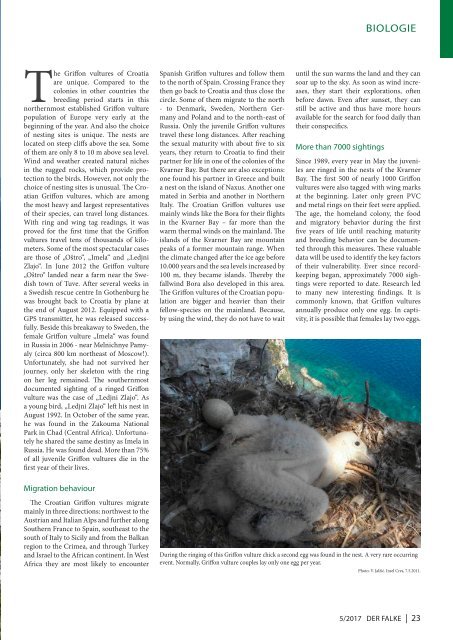Create successful ePaper yourself
Turn your PDF publications into a flip-book with our unique Google optimized e-Paper software.
BIOLOGIE<br />
The <strong>Griffon</strong> <strong>vultures</strong> of <strong>Croatia</strong><br />
are unique. Compared to the<br />
colonies in other countries the<br />
breeding period starts in this<br />
northernmost established <strong>Griffon</strong> vulture<br />
population of Europe very early at the<br />
beginning of the year. And also the choice<br />
of nesting sites is unique. The nests are<br />
located on steep cliffs above the sea. Some<br />
of them are only 8 to 10 m above sea level.<br />
Wind and weather created natural niches<br />
in the rugged rocks, which provide protection<br />
to the birds. However, not only the<br />
choice of nesting sites is unusual. The <strong>Croatia</strong>n<br />
<strong>Griffon</strong> <strong>vultures</strong>, which are among<br />
the most heavy and largest representatives<br />
of their species, can travel long distances.<br />
With ring and wing tag readings, it was<br />
proved for the first time that the <strong>Griffon</strong><br />
<strong>vultures</strong> travel tens of thousands of kilometers.<br />
Some of the most spectacular cases<br />
are those of „Oštro“, „Imela“ and „Ledjni<br />
Zlajo“. In June 2012 the <strong>Griffon</strong> vulture<br />
„Oštro“ landed near a farm near the Swedish<br />
town of Tuve. After several weeks in<br />
a Swedish rescue centre In Gothenburg he<br />
was brought back to <strong>Croatia</strong> by plane at<br />
the end of August 2012. Equipped with a<br />
GPS transmitter, he was released successfully.<br />
Beside this breakaway to Sweden, the<br />
female <strong>Griffon</strong> vulture „Imela“ was found<br />
in Russia in 2006 - near Melnichnye Pamyaly<br />
(circa 800 km northeast of Moscow!).<br />
Unfortunately, she had not survived her<br />
journey, only her skeleton with the ring<br />
on her leg remained. The southernmost<br />
documented sighting of a ringed <strong>Griffon</strong><br />
vulture was the case of „Ledjni Zlajo“. As<br />
a young bird, „Ledjni Zlajo“ left his nest in<br />
August 1992. In October of the same year,<br />
he was found in the Zakouma National<br />
Park in Chad (Central Africa). Unfortunately<br />
he shared the same destiny as Imela in<br />
Russia. He was found dead. More than 75%<br />
of all juvenile <strong>Griffon</strong> <strong>vultures</strong> die in the<br />
first year of their lives.<br />
Spanish <strong>Griffon</strong> <strong>vultures</strong> and follow them<br />
to the north of Spain. Crossing France they<br />
then go back to <strong>Croatia</strong> and thus close the<br />
circle. Some of them migrate to the north<br />
- to Denmark, Sweden, Northern Germany<br />
and Poland and to the north-east of<br />
Russia. Only the juvenile <strong>Griffon</strong> <strong>vultures</strong><br />
travel these long distances. After reaching<br />
the sexual maturity with about five to six<br />
years, they return to <strong>Croatia</strong> to find their<br />
partner for life in one of the colonies of the<br />
Kvarner Bay. But there are also exceptions:<br />
one found his partner in Greece and built<br />
a nest on the island of Naxus. Another one<br />
mated in Serbia and another in Northern<br />
Italy. The <strong>Croatia</strong>n <strong>Griffon</strong> <strong>vultures</strong> use<br />
mainly winds like the Bora for their flights<br />
in the Kvarner Bay – far more than the<br />
warm thermal winds on the mainland. The<br />
islands of the Kvarner Bay are mountain<br />
peaks of a former mountain range. When<br />
the climate changed after the ice age before<br />
10.000 years and the sea levels increased by<br />
100 m, they became islands. Thereby the<br />
fallwind Bora also developed in this area.<br />
The <strong>Griffon</strong> <strong>vultures</strong> of the <strong>Croatia</strong>n population<br />
are bigger and heavier than their<br />
fellow-species on the mainland. Because,<br />
by using the wind, they do not have to wait<br />
until the sun warms the land and they can<br />
soar up to the sky. As soon as wind increases,<br />
they start their explorations, often<br />
before dawn. Even after sunset, they can<br />
still be active and thus have more hours<br />
available for the search for food daily than<br />
their conspecifics.<br />
More than 7000 sightings<br />
Since 1989, every year in May the juveniles<br />
are ringed in the nests of the Kvarner<br />
Bay. The first 500 of nearly 1000 <strong>Griffon</strong><br />
<strong>vultures</strong> were also tagged with wing marks<br />
at the beginning. Later only green PVC<br />
and metal rings on their feet were applied.<br />
The age, the homeland colony, the food<br />
and migratory behavior during the first<br />
five years of life until reaching maturity<br />
and breeding behavior can be documented<br />
through this measures. These valuable<br />
data will be used to identify the key factors<br />
of their vulnerability. Ever since recordkeeping<br />
began, approximately 7000 sightings<br />
were reported to date. Research led<br />
to many new interesting findings. It is<br />
commonly known, that <strong>Griffon</strong> <strong>vultures</strong><br />
annually produce only one egg. In captivity,<br />
it is possible that females lay two eggs.<br />
Migration behaviour<br />
The <strong>Croatia</strong>n <strong>Griffon</strong> <strong>vultures</strong> migrate<br />
mainly in three directions: northwest to the<br />
Austrian and Italian Alps and further along<br />
Southern France to Spain, southeast to the<br />
south of Italy to Sicily and from the Balkan<br />
region to the Crimea, and through Turkey<br />
and Israel to the African continent. In West<br />
Africa they are most likely to encounter<br />
During the ringing of this <strong>Griffon</strong> vulture chick a second egg was found in the nest. A very rare occurring<br />
event. Normally, <strong>Griffon</strong> vulture couples lay only one egg per year.<br />
Photo: V. Jalžić. Insel Cres, 7.5.2011.<br />
5/2017 DER FALKE | 23


